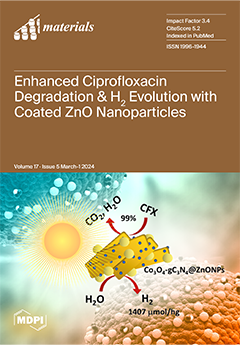The inherent properties of TiO
2, including a wide band gap and restricted spectral response range, hinder its commercial application and its ability to harness only 2–3% of solar energy. To address these challenges and unlock TiO
2’s full potential in
[...] Read more.
The inherent properties of TiO
2, including a wide band gap and restricted spectral response range, hinder its commercial application and its ability to harness only 2–3% of solar energy. To address these challenges and unlock TiO
2’s full potential in photocatalysis, C
60- and CdS-co-modified nano-titanium dioxide has been adopted in this work to reduce the band gap, extend the absorption wavelength, and control photogenerated carrier recombination, thereby enhancing TiO
2’s light-energy-harnessing capabilities and hydrogen evolution capacity. Using the sol-gel method, we successfully synthesized CdS-C
60/TiO
2 composite nanomaterials, harnessing the unique strengths of CdS and C
60. The results showed a remarkable average yield of 34.025 μmol/h for TiO
2 co-modified with CdS and C
60, representing a substantial 17-fold increase compared to pure CdS. Simultaneously, the average hydrogen generation of C
60-modified CdS surged to 5.648 μmol/h, a notable two-fold improvement over pure CdS. This work opens up a new avenue for the substantial improvement of both the photocatalytic degradation efficiency and hydrogen evolution capacity, offering promise of a brighter future in photocatalysis research.
Full article






